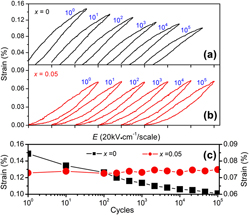Article contents
Effect of (Bi0.5K0.5)TiO3 on the electrical properties, thermal and fatigue behavior of (K0.5Na0.5)NbO3-based lead-free piezoelectrics
Published online by Cambridge University Press: 23 June 2015
Abstract

The (1 − x)[0.94(K0.5Na0.5)NbO3–0.06LiNbO3]–x(Bi0.5K0.5)TiO3 (abbreviated as: KNLN6–xBKT, x = 0–0.05) lead-free piezoelectric ceramics were prepared using conventional solid sintering method. The effects of BKT on the phase structure, electrical properties, temperature stability, and fatigue behavior of KNLN6 ceramics were systematically studied. Results show that BKT substitution into KNLN6 induces a phase transition from coexistence of orthorhombic and tetragonal phases to a single tetragonal phase with a normal-relaxor ferroelectric transformation and correspondingly shifts the polymorphic phase transition below room temperature. Accordingly, the temperature stability of the properties is significantly improved, and a flat, temperature stable behavior over the temperature range of 25–150 °C is observed in BKT-modified ceramics. Temperature-dependent structural analysis suggests that the good properties insensitive to temperature of the modified samples can be ascribed to the stable tetragonal phase over a wide temperature range, evident by the almost unchanged tetragonality c/a ratio with temperature. Moreover, the BKT-modified ceramics not only exhibit temperature-independent characteristic but also possess fatigue-free behavior. All the electric parameters, including unipolar/bipolar strain S, remnant polarization Pr, permittivity εr, and large signal d33*, display no degradation up to 105 switching cycles. The exceptionally good fatigue resistance and temperature stable behavior make the modified KNN-based materials excellent candidates for lead-free actuators and transducers.
- Type
- Articles
- Information
- Copyright
- Copyright © Materials Research Society 2015
References
REFERENCES
- 15
- Cited by


